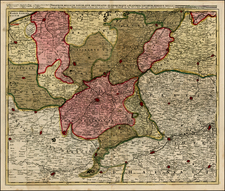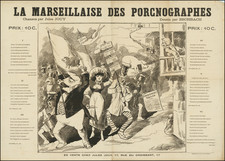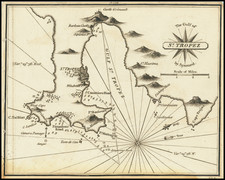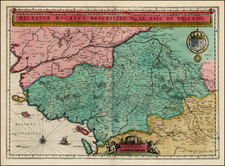Rare Sweeping View of Paris Showing the City Under Louis XIV
The first French-published view of Paris at such a large scale. This superbly rare bird's-eye view was designed by Noël Cochin and printed by Hubert Jaillot in 1669. The expansive central view, nearly 7 feet wide and 2 feet tall, shows the city in intricate detail as seen from the north. This is one of the earliest obtainable views of Paris to be published on this scale, and one of the grandest views of Paris published during the 17th century.
The view sweeps from the Faubourg and Abbaye de St. Antoine (near the younger Place de la Nation) in the east to the hills of Montmartre in the north. The exact location Cochin used to sketch the view is not mentioned in the text, but the angle of the buildings suggests somewhere in northeast Paris, in the 20th Arrondissement. The Princeton catalog suggests the Ménilmontant neighborhood as the location Cochin used. While plausible, there is no textual evidence to support this.
The central view, itself supplied on four sixteen- by twenty-one-inch sheets of paper, is supplemented by four additional wide-angled views of the city and fourteen additional smaller views in the side and bottom panels of the work. Below the engravings are four sets of text, the first explaining the purpose of the view; the second detailing the history of Paris in French; the third providing the same in Latin; and the fourth acting as an additional index for the central view. Please refer to the text below for specifics regarding the text and additional views.
On the central view, the grand buildings and sites of Paris which can be seen include, from left to right: the Faubourg St. Antoine; the Faubourg St. Marceau; Les Cordeliers; the Faubourg St. Jacques; the Bastille; the old cathedral at St. Etienne; the Sorbonne; Notre Dame; the church of St. Gervais; the Louvre; the ancient Grosse Tour of Le Temple; and Montmartre. The view is dominated by just a few of these buildings, with the imposing facade of Notre Dame standing high above the city. Behind the city, the hills of the south of Paris are depicted with small towns such as Montrouge (now agglomerated into Paris) depicted. The foreground includes a compass rose alongside curious depictions of Parisian nobility, merchants, and denizens enjoying the countryside. Above the city float coats of arms of the city of Paris and of the monarchy, as well as smaller coats of arms belonging to city officials.
Boutier only lists two earlier views of Paris produced at a comparable size (one plate created by Van der Keere and one created by Willem Janszoon Blaeu), although each is approximately a foot smaller. These were both published in Amsterdam and reproductions of an earlier and smaller Merian view, which highlights the importance of this present map.
This is Boutier's third (of 3) and rarest state of the view, with only one other known example, possessed by the BNF. In all, this is a supremely impressive view of one of the most important cities in the world at a time when it was entering its modern era.
Panel Illustrations
The four views at the base of the map show meticulous detail regarding the workings of the central city. The leftmost map shows the Île de la Cité viewed from the west, with the Louvre on the left, the Pont Neuf with the original statue of Henry IV, and the towers of Notre Dame. The second view shows the same view from slightly further downriver, on the other side of the Île-St-Louis. The third view shows the location of the Hotel de Ville (town hall) and the former Place de Greve, namesake of the French art of the strike. The rightmost view again shows the Seine and the former design of the Pont-Saint-Michel.
The smaller side panel illustrations show the young king Louis XIV and the Duc D'Anjou alongside twelve detailed views of palaces, churches, and squares, including the Louvre, the Tuileries, and the Bastille.
Text
The title of the work translates to:
Lutetiae (commonly called) Paris, the French City, Best Not Only in Europe but in the Whole World, Seen From Most Perspectives
The description of Paris at the base of the map profusely praises the city, bestowing upon it numerous superlatives, likely to aid the engraver's quest to gain political favor. Subsequently, the text denotes the history of Paris, eschewing discussions of the origins of the name of Paris as these "a stone so often and so uselessly overturned." The history discusses the first appearance of Lutetiae in Ceasar's Book 7 of his commentaries and then details the growth of the city through subsequent French kings. The text concludes by providing an overview of the demographic, geographic, and cultural aspects of the city.
Paris During Le Grand Siècle
The reign of Louis XIV saw the growing dominance of France on the world stage, as well as many reforms of French society. Louis XIV would only truly come into power after the suppression of the Fronde rebellion, but this would leave him with a life-long distrust of the Parisian nobility and denizens. Thus, he would change the royal residence from the Palais-Royale first to the more defensible Louvre, and then to Versailles some twenty kilometers from Paris.
Despite the king's distaste for the city, it would flourish due to the actions of Jean-Baptiste Colbert, the Minister of Finances and a gifted student of mercantilism. In a quest to remake Paris in the style of Rome, he would undertake massive construction projects, building Les Invalides just two years after the printing of this work, demolishing the city walls and replacing them with the Grands Boulevards (but only after Louis XIV declared the city secure against attack), and building many additional squares and monuments. This view, and the associated view, were no doubt influenced by the grandiose redesigning of the city.
States and Reproductions
Boutier lists the map as appearing in three states, identifiable as follows:
- State 1: The address in the rightmost coat of arms reads "A Paris chez N Berey Pres les Augustins aux deux Globes Avec privilege du Roy." This state is dated 1662.
- Boutier fails to note that this state appears both with a complete host of coats of arms in the top and some of the coats of arms erased (see below). This likely means that Berey reprinted the map at some point between 1662 and his death in 1665,
- State 2: The address has been updated to read: "A Paris chez H Jalliot Pres les Augustins aux deux Globes." This state is undated, but Boutier hypothesizes that this is from the period 1666-1670, when Jalliot published without substantial modification many plates inherited from Berey (his father-in-law). Boutier classes this as the second state, although it may, in fact, be the third.
- State 3: This state is identical to the second state, but dated.
- While the central view appears unchanged, numerous changes were made to the panel views. The French language text in the center-left was also edited. Please refer to the section below regarding changes in the panel views.
Several reprints were also made of this work. Jaillot made a miniature edition of this view 1669, while Frederick de Widt published one full-sized version (lacking text and panel illustrations) in Amsterdam sometime after 1662.
The design of the coats of arms changes during the work's printed history, although this is not noted by Boutier. It can be seen in the presented example, and in the first state example held by the BNF, that six of the twelve coats of arms have been erased in the third state, with five of the underlying names changed. Curiously the sixth name, (M. Nicolas Boucot, Receueur de la Ville), remains unchanged, despite the coat of arms being replaced. We were unable to trace the reasons for this change, which may simply reflect a change in family heraldry, an oversight by the publisher, or a falling from favor. The rest of the changes in names appear to reflect newly-appointed representatives of the city.
La Porte Neuve
A fascinating change to the lower-left view of the Louvre was made by Jaillot, replacing the recently demolished Porte Neuve. As can be seen immediately above the Description Sommaire on the presented example, a mysterious disappearing staircase can be seen with the torso of a laborer visible emanating from a stone wall in the Louvre. This represents the ghost of the Porte Neuve, a former entrance into Paris from the east, which was demolished prior to the creation of the third state of the view.
The Porte had a short history, built to replace a previous structure (La Tour du Bois) in 1537. The door would be used as Henri III's escape route from Paris when fleeing from the Ligue Catholique, and it would be from this same door that his successor Henri IV would retake the city. The tower and the door would be demolished and replaced by the Porte de la Conference, built at the far western end of the Louvre. Sources differ on when the Porte Neuve was demolished, however, the edits to this presented map date this change to between 1662 and 1669.
Rarity
- First state: three examples, in the Firestone Library (Princeton University), the Getty Research Center (California), and the Bibliotheque National de France.
- Second state: we were only able to locate one example, in the BNF.
- Third state: we were again able to locate only one example, in the BNF.
One further mention of this work exists, in the Catalogue de Livres et Estampes Relatifs à L'Histoire de la Ville de Paris et de ses Environs, Provenant de la Bibliothèque de Feu M. Hippolyte Destailleur, which documents the extensive library the famous architect and Rococo revivalist upon his death. This print was also mentioned in Sue Reed's 1998 French Prints From the Age of the Musketeers, stating that the print was on loan to an exhibition held in Boston, Ottawa, and Paris from 1998 to 1999 (most likely the BNF first state example).
We find no record of any additional examples having ever been on the market.
Alexis-Hubert Jaillot (ca. 1632-1712) was one of the most important French cartographers of the seventeenth century. Jaillot traveled to Paris with his brother, Simon, in 1657, hoping to take advantage of Louis XIV's call to the artists and scientists of France to settle and work in Paris. Originally a sculptor, he married the daughter of Nicholas Berey, Jeanne Berey, in 1664, and went into partnership with Nicholas Sanson's sons. Beginning in 1669, he re-engraved and often enlarged many of Sanson's maps, filling in the gap left by the destruction of the Blaeu's printing establishment in 1672.











![[Paris - Soissons - Champagne / area between the Seine River, Oise, River, Aisne River and Marne Rivers]](https://storage.googleapis.com/raremaps/img/small/90932.jpg)


![[ Holy Roman Empire, Poland, Baltic, etc. ] Germania VI Nova Tabula (First state!)](https://storage.googleapis.com/raremaps/img/small/94645.jpg)

